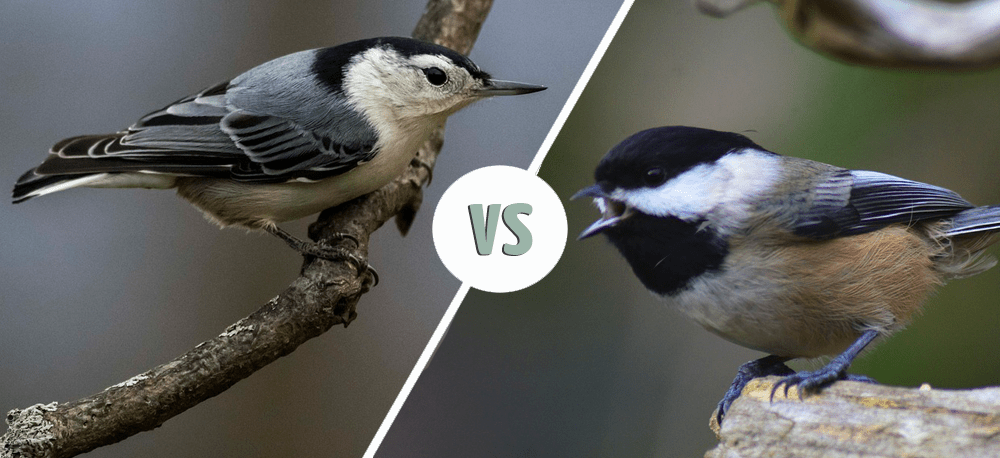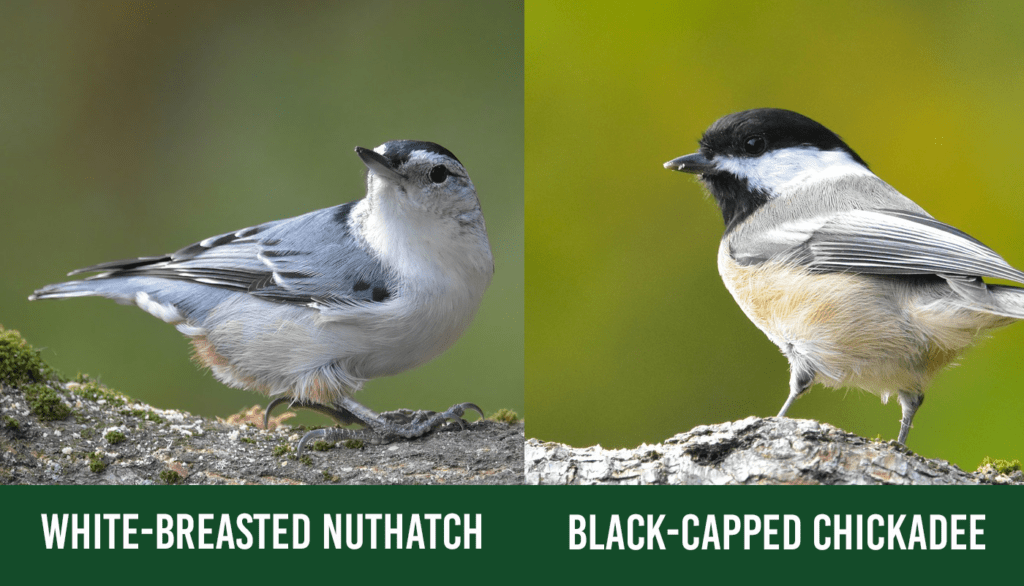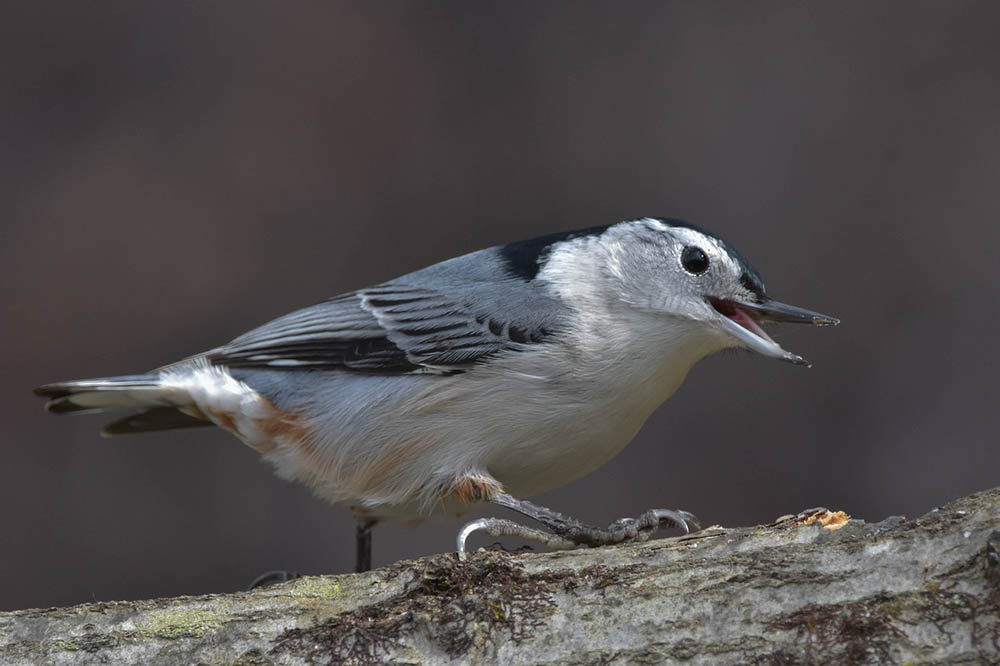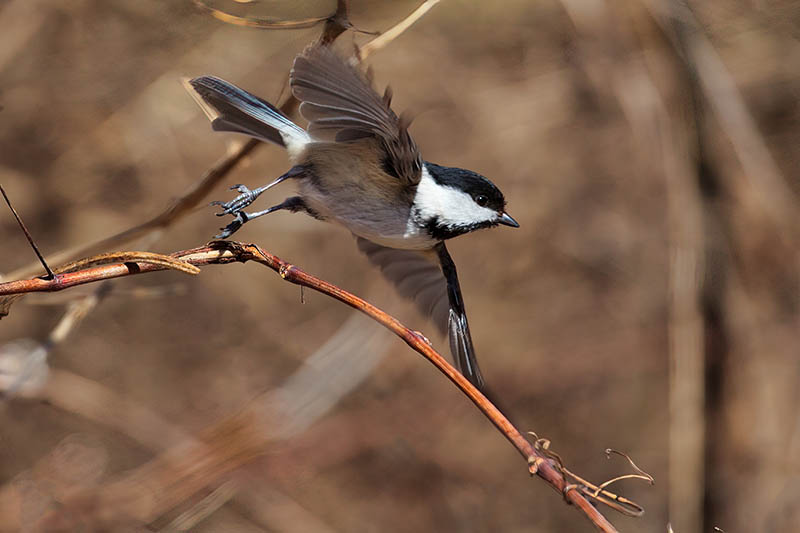Nuthatch vs Chickadee: How to Tell the Difference (With Pictures)
Last Updated on

There are four nuthatch species and five chickadee species that frequent the coniferous forests in North America. Both are petite songbirds that like to nestle into their homes, usually in evergreen trees or human-made cavities such as city park lanterns. They’re non-migratory, which means if you find one, you’ll likely see it return often for the rest of its life.
Depending on the particular species, you will even find them in the same places. They’re friendly to other species of birds that are similarly sized, including each other, and they share a lot in common even in appearance. The “cap” on the head of the Brown-headed Nuthatch looks a lot like the one on the Black-capped Chickadee except for the color. Out of all the species, the White-breasted Nuthatch and the Black-capped Chickadee are the most widespread across North America, so we’ll compare those directly.

Visual Differences

At a Glance
- Origin: North America
- Wingspan: 9-10.6 in.
- Length: 1-5.5 in.
- Food: Insects
- Lifespan: Up to 9 years
- Origin: North America
- Wingspan:3-8.3 in.
- Length: 7-5.9 in.
- Food: Insects
- Lifespan: Up to 11 years

White-Breasted Nuthatch

Characteristics & Appearance
This petite bird has similar colorings to a blue jay but is much smaller. Males and females have a gray-blue back with a beige belly. True to their name, the White-breasted Nuthatch has an ivory breast and face. They also have a few rusty feathers under their rear. Females have a gray cap on their heads instead of a black cap like the males, which is the biggest difference in appearance between the genders. Other than that, it is hard to distinguish between the sexes because they’re the same size. The White-breasted Nuthatch is the largest Nuthatch species and is a little bigger than Black-capped Chickadees but is still considered a small bird overall.
Habitat and Feeding
Unlike other Nuthatch species, which are mostly limited to a certain region, the White-breasted Nuthatch can be found almost anywhere in North America. They like to stay in non-migratory flocks, living in communities near human dwellings or in natural tree cavities in the forest. They feed mostly off of insects that they peck out of trees, but can also eat seeds, nuts, and corn.
Black-Capped Chickadee

Characteristics & Appearance
Although there are five Chickadee species in North America, the Black-capped one is the most common and probably sets our expectations for how chickadees look in general. They have a black circle on their head that comes down right below their eyes. This is called their “cap,” which is how they get their name. Black-capped Chickadees have a streak of white on the side of their faces. Its feathers are gray, white, and buff on its body, which tends to be small and plump. Unlike most bird species, males and females look identical.
Habitat and Feeding
Black-capped Chickadees live everywhere in the U.S. north of Texas. They like to reside in flocks with similar birds, such as the nuthatch and the titmouse, and tend to build their nests in trees or human-made cavities. They’ll mostly eat insects that they forage from the woods during the spring through fall, but they enjoy seeds and berries in the winter. 
Differences Between the White-Breasted Nuthatch & the Black-Capped Chickadee:

The White-breasted Nuthatch is so much like the Black-capped Chickadee that they flock together. Not only do they seem to enjoy each other’s company, but doing life together helps to guard against potential predators by keeping the group alert. Both are small songbirds that occupy some of the same regions of the United States, but there are some key differences between the two.
Although both birds are small, the Black-capped Chickadee has a wingspan that’s approximately 1 ½ inches smaller than the White-breasted Nuthatch. While both birds predominately feed on insects and eat seeds, especially during the cooler months, the Black-capped Chickadee may also supplement its diet with berries in the winter.
More obviously, the White-breasted Nuthatch has grayish-blue feathers on its back with a black or gray head, while the Black-capped Chickadee features a black head with white, buff, and gray feathers on its body.
Conclusion
If you live near a forest in North America, chances are you can spot the Black-capped Chickadee and the White-breasted Nuthatch—maybe even at the same time. These birds like to nest in natural cavities in the trees, even old woodpecker nests, but they may also make their home in a bird house or human-made structure. You can set out a bird feeder for them that’s supplied with suet, sunflower seeds, and peanuts. These friendly birds will probably come to pay you a visit, especially in the wintertime when insects are harder to find.
Featured Image Credit: Left: (white-breasted nuthatch) rusticpix_cheryl , Right: (black-capped chickadee) bryanhanson1956, Pixabay
About the Author Robert Sparks
Robert’s obsession with all things optical started early in life, when his optician father would bring home prototypes for Robert to play with. Nowadays, Robert is dedicated to helping others find the right optics for their needs. His hobbies include astronomy, astrophysics, and model building. Originally from Newark, NJ, he resides in Santa Fe, New Mexico, where the nighttime skies are filled with glittering stars.
Related Articles:
Monocular vs Telescope: Differences Explained (With Pictures)
10 Types of Hummingbirds in Arkansas (With Pictures)
8 Types of Hummingbirds in Nebraska (With Pictures)
5 Types of Hummingbirds in Idaho (With Pictures)
3 Types of Hummingbirds in Mississippi (With Pictures)
8 Types of Hummingbirds in Kansas (With Pictures)
5 Types of Hummingbirds in West Virginia (With Pictures)
5 Types of Hummingbirds in Ohio (With Pictures)
